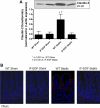Enterocyte-specific epidermal growth factor prevents barrier dysfunction and improves mortality in murine peritonitis
- PMID: 19571236
- PMCID: PMC2739816
- DOI: 10.1152/ajpgi.00012.2009
Enterocyte-specific epidermal growth factor prevents barrier dysfunction and improves mortality in murine peritonitis
Abstract
Systemic administration of epidermal growth factor (EGF) decreases mortality in a murine model of septic peritonitis. Although EGF can have direct healing effects on the intestinal mucosa, it is unknown whether the benefits of systemic EGF in peritonitis are mediated through the intestine. Here, we demonstrate that enterocyte-specific overexpression of EGF is sufficient to prevent intestinal barrier dysfunction and improve survival in peritonitis. Transgenic FVB/N mice that overexpress EGF exclusively in enterocytes (IFABP-EGF) and wild-type (WT) mice were subjected to either sham laparotomy or cecal ligation and puncture (CLP). Intestinal permeability, expression of the tight junction proteins claudins-1, -2, -3, -4, -5, -7, and -8, occludin, and zonula occludens-1; villus length; intestinal epithelial proliferation; and epithelial apoptosis were evaluated. A separate cohort of mice was followed for survival. Peritonitis induced a threefold increase in intestinal permeability in WT mice. This was associated with increased claudin-2 expression and a change in subcellular localization. Permeability decreased to basal levels in IFABP-EGF septic mice, and claudin-2 expression and localization were similar to those of sham animals. Claudin-4 expression was decreased following CLP but was not different between WT septic mice and IFABP-EGF septic mice. Peritonitis-induced decreases in villus length and proliferation and increases in apoptosis seen in WT septic mice did not occur in IFABP-EGF septic mice. IFABP-EGF mice had improved 7-day mortality compared with WT septic mice (6% vs. 64%). Since enterocyte-specific overexpression of EGF is sufficient to prevent peritonitis-induced intestinal barrier dysfunction and confers a survival advantage, the protective effects of systemic EGF in septic peritonitis appear to be mediated in an intestine-specific fashion.
Figures








References
-
- Angus DC, Linde-Zwirble WT, Lidicker J, Clermont G, Carcillo J, Pinsky MR. Epidemiology of severe sepsis in the United States: analysis of incidence, outcome, and associated costs of care. Crit Care Med 29: 1303–1310, 2001. - PubMed
-
- Baker CC, Chaudry IH, Gaines HO, Baue AE. Evaluation of factors affecting mortality rate after sepsis in a murine cecal ligation and puncture model. Surgery 94: 331–335, 1983. - PubMed
-
- Basuroy S, Sheth P, Mansbach CM, Rao RK. Acetaldehyde disrupts tight junctions and adherens junctions in human colonic mucosa: protection by EGF and l-glutamine. Am J Physiol Gastrointest Liver Physiol 289: G367–G375, 2005. - PubMed
-
- Berlanga J, Lodos J, Lopez-Saura P. Attenuation of internal organ damages by exogenously administered epidermal growth factor (EGF) in burned rodents. Burns 28: 435–442, 2002. - PubMed
Publication types
MeSH terms
Substances
Grants and funding
LinkOut - more resources
Full Text Sources
Molecular Biology Databases
Miscellaneous

